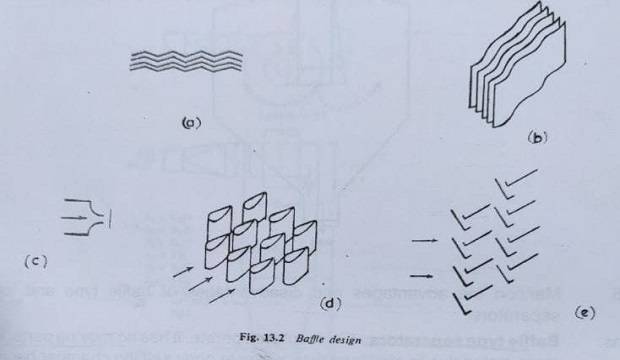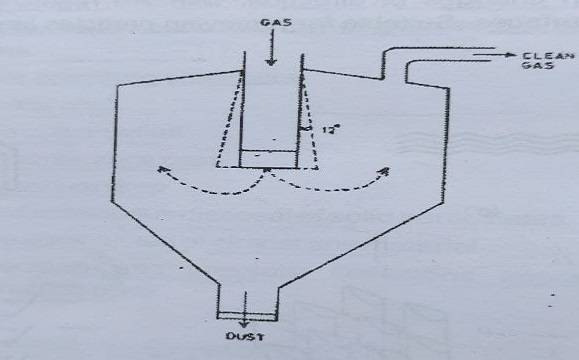1. Low initial costat
2. Simple construction
3. Low maintenance cost
4. Low pressure drop
5. Dry and continuous disposal of solid particulates
6. Can be constructed of almost any material
7. Temperature and pressure limitations imposed only by materials of construction used.
Disadvantages settling chambers:
1. Large space requirements
2. Only comparatively large particles (definitely not less than 10 microns, if very dense and 40 microns if of low density) can be controlled
Applications: Industrial application of this equipment is limited. Settling chambers are used widely for the removal of large solid particulates from natural draft furnaces, to kilns etc. They are also sometimes used in the process industries, particularly the food and metallurgical industries, as a first step in dust control.
Because of simplicity of construction and low maintenance costs, gravity settling chambers have found quite widespread applications as pre cleaners for high ed efficiency collectors.
This reduces the inlet dust loadings to the second stage Wolor cleaner and can remove large highly abrasive materials thus reducing maintenance costs of high efficiency equipments which is more subject to abrasive deterioration.
Explain with neat sketch the principle, construction and working of a settling chamber. How can its efficiency be improved?
The settling chamber is the simplest type of equipment used for the collection of solid particles. It consists of a chamber in which the carrier gas velocity is reduced so as to allow the particulates to settle out of the moving stream under the action of gravity.

The most common form is a long box like structure with an inlet at one end and an outlet at the other, set horizontally, often on the ground. It can be constructed from brick and concrete.
The carrier gas is made to pass at the low velocities. The solid particulates having higher density than the surrounding gas, settle under the influence of gravity on the base of the chamber from where they are removed through hoppers.
The gas velocity should be less than about 3m/sec to preventre entrainment of the settled particles and less than 0.5m/sec for good results.
Installation costs are low because of the simple structure.
The efficiency can be improved by decreasing the height to be traveled by the particles and sometimes by incorporating horizontal trays or shelves in the chambers.
Control of air pollution by Equipment (Settling chambers and ESP)
What is the principle of inertial separators? Mention the types of inertial separators.
Inertial separators type of control equipment include all collectors which utilize the relatively greater inertia of the dispersoid to effect the particulate-gas separation.
Two types of equipments utilize this fundamental principle. They are inertial or impact separators and cyclonic separators.
Inertial or impact separators. They employ incremental changes of direction of the carrier gas stream to exert the greater inertial effects of the dispersoid.
Cyclonic separators-They produce a continuous centrifugal force as a means of exerting the greater inertial effects of the dispersoid.
1. Baffle type separators – This is simplest type of impingement separator. The gas stream is made to follow a tortuous flow path, which is obtained by the insertion of staggered plates into the path of the gas stream. As a result the gas is subjected to a series of sudden changes of direction, with the resulting impaction of the particles on solid surfaces. Suitable for removing particles larger than 20microns in diameter.

2. Louvre type separator- In this a series of louvers or impingement elements set at an angle to the carrier gas stream so as to cause a rapid reversal of the gas flow direction and thereby cause the particulates to impinge on the louvers. The particles thus impinged rebound back into the moving gas stream in the inlet chamber and are removed from the collector by a secondary air circuit Suitable for removing particles larger than 30microns in diameter.

3. Dust trap. In this device dust laden gas is introduced into a central pipe (cylindrical or tapered) and is made to undergo a change in direction by 180 degree. Dust because of inertia settles in the conical chamber. This is useful when dust loading is high and quantity of gas to be handled is low.

Mention the advantages and disadvantages of baffle type and louver type separators
Baffle type separators.- It is simple to operate. It has no moving parts. It is slightly more expensive to construct than a simple open settling chamber because of the interior work involved in fabricating and installing the baffles. But owing to high impaction velocity, abrasion is often severe. The efficiency is totally dependent on the degree of impaction which occurs. Efficiency is a function of four variables, number, length spacing and configuration of the baffles. It is widely used for con particulate removal in power plants and rotary kilns.
Louvre type – The advantages of louver type of dust collector are simple and low cost of construction as well as moderate low pressure drop for the degree of removal obtained. The disadvantages are clogging of the louver grid with a corresponding reduction in efficiency and excessive abrasion of louver elements.
Explain the principle, construction and working of a cyclone separator.
Cyclone separators depend on centrifugal force for its action. A cyclone separator can be defined as a structure without moving parts in which the velocity of an inlet gas stream is transformed into a confined vortex from which centrifugal forces tend to drive the suspended particles to the wall of the cyclone body.
It consists of a vertically placed cylinder which has an inverted cone attached to its base.
The particulate laden gas stream enters tangentially at the inlet point into the cylinder. The outlet pipe for the purified gas is a central cylindrical opening at the top.
The dust particulates are collected at the bottom in a storage hopper.
The gas path generally follows a double vortex. First the gas spirals downwards at the outer periphery of the cylindrical portion continues through the conical portion and reaches the bottom.
The stream then moves upwards in a narrower inner spiral concentric with the first and leaves through the outlet pipe.

Due to rapid spiraling movement of the gas the dispersoids are projected towards the wall by the centrifugal force and then they drop by gravity to the bottom of the body, where they are collected in the storage hopper.
During cyclonic separation, carrier gas rotational velocity may exceed several times the average inlet gas velocity
Centrifugal force vary from 5 to 2500 times gravity depending on the diameter of the cyclone. Efficiency are greater than 90% for particles with diameter of 10 microns and is about 95% for diameters higher than 20microns.
What are the objectives of using control equipments? List the various types of collection equipments for particulates.
Objectives of using control equipments are
1. Prevention of nuisance
2 Prevention of physical damage to property
3. Elimination.of health hazards to plant, personnel and to the general population
4. Recovery of valuable waste products
5. Minimization of economic losses through the reduction of plant maintenance
6. Improvement of product quality
Types of collection equipments for the particulates are
1. Settling chambers Blounts to bolouenea dns
2. Inertial separators anonimi eng bois qugjeqmer
3. Cyclones
4. Fillters
5. Electrostatic precipitators
6. Scrubbers or wet collectors
Also Read This.